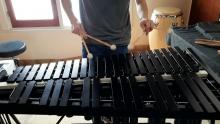A Chorus of Whisper Not From The Road
My philosophy is kind of simple. You get better by making things sound good. By playing things well. If you're learning a melody and really trying to play it well, you're getting better. If you're transcribing a solo and making it sound as good as you can, you're getting better. If you're working on a tune and working out a solo, figuring out how to get through the changes, you are getting better.
- Read more about A Chorus of Whisper Not From The Road
- Log in or register to post comments




